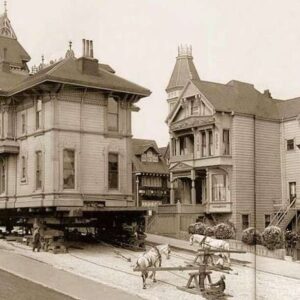A Barge Maneuvering Under the Michigan Avenue Bridge (1953)
In 1953, a barge carefully made its way under the Michigan Avenue Bridge in Chicago, a sight that was both ordinary and remarkable. The Michigan Avenue Bridge, now known as the DuSable Bridge, has long been a crucial link over the Chicago River, connecting the bustling downtown area with the city’s vibrant North Side.

During this era, Chicago was a hub of industry and transportation, relying heavily on its waterways to move goods efficiently. Barges like the one in this iconic image played a key role in transporting coal, grain, and other essential materials through the city’s intricate network of rivers and canals. Unlike modern motorized vessels, many barges at the time were guided by tugboats, requiring skillful maneuvering to navigate the narrow waterway and pass safely beneath the bridge.

The Michigan Avenue Bridge itself, completed in 1920, is a double-leaf bascule bridge, meaning it can be raised to allow tall ships and barges to pass through. In 1953, bridge tenders would have coordinated the lifting process, halting traffic momentarily as the massive steel structure slowly opened. For pedestrians and motorists, this was a regular but fascinating event, offering a brief glimpse into Chicago’s bustling maritime activity.

This moment in history captures not just the movement of goods but also the rhythm of life in a city that was evolving rapidly. The sight of a barge maneuvering under the bridge symbolized Chicago’s identity as a center of commerce, where industry and daily life intersected seamlessly. Today, while the city’s waterways are less central to freight transport, the Michigan Avenue Bridge remains a historic landmark, reminding us of a time when the river was the lifeblood of Chicago’s economy.





